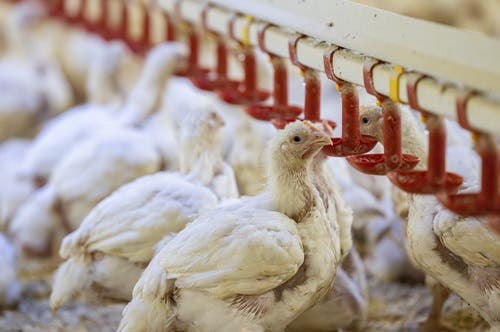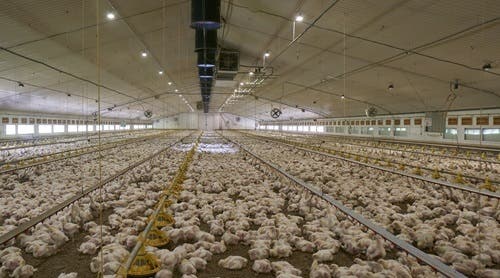How does coccidiosis affect poultry production?
Coccidiosis is a prevalent parasitic disease that is a significant concern for poultry production, due to its productivity and economic impacts.
Estimated to cost the global broiler industry £10.5 billion annually, and more specifically the UK poultry industry approximately £108 million1, coccidiosis can have a significant impact on the sector.
Understanding how this disease affects poultry is crucial for effective management and control strategies.
This article delves into the effects of coccidiosis in poultry, covering the economic and performance impacts.
What is coccidiosis in poultry?
Coccidiosis in poultry is an intestinal disease caused by protozoan parasites from the genus Eimeria.
These parasites invade the gut lining, causing tissue damage, reduced nutrient absorption, and increased susceptibility to other diseases.
The severity of the disease can vary, but it often leads to poor growth rates, reduced feed efficiency, and higher mortality rates. Wider than the loss of production this can cause, it also affects intestinal health, leading to poor gut health and issues like necrotic enteritis, hock burn, and footpad dermatitis.
Performance impacts of poultry coccidiosis
As coccidiosis significantly affects the performance of poultry, Elanco has developed the Health Tracking System (HTSi), an established, independently verified and data-led benchmarking platform to help monitor coccidiosis levels.
Developed to consistently and reliably assess intestinal health, the Intestinal Integrity (I2) score, is a measure of gut health, and ultimately bird performance.
Birds infected with coccidia often exhibit reduced feed intake and poor feed conversion, leading to lower growth rates and reduced overall productivity. The disease can also cause secondary health issues such as necrotic enteritis, hock burn, and footpad dermatitis.

Necrotic enteritis in particular exacerbates performance issues by further damaging the gut lining and impairing nutrient absorption. This leads to increased mortality and further reduction in feed efficiency.
Broiler feed conversion ratio
Broiler feed conversion ratio (FCR) is a critical measure of poultry production efficiency, representing the amount of feed required to gain a unit of body weight. Coccidiosis negatively impacts broiler FCR by causing poor nutrient absorption and increased feed wastage.
Studies have shown that effective coccidiosis control can lead to better FCR, improved average daily gain (ADG), and higher liveability rates.
The HTSi report, which incorporates several years of I2 data, indicates that for every one- point increase in I2, the following benefits can be seen:
- ADG increases by 0.04g2
- EPEF (European Production Efficiency Factor) increases by 0.522
- FCR decreases by 0.13pts2
- Liveability increases by 5%3
Environmental conditions
Coccidiosis also contributes to other health issues in poultry, such as hock burn and footpad dermatitis.
These conditions are often related to wet litter, a common consequence of coccidiosis, due to diarrhoea and poor litter quality.
Managing coccidiosis helps in reducing the incidence of these damaging conditions, thereby improving overall bird welfare.
Economic impacts of poultry coccidiosis

The economic impact of poultry coccidiosis is substantial. Poor control of the disease can lead to reduced efficiency and performance, resulting in higher feed costs, elevated mortality rates and longer days to slaughter.
The impact of coccidiosis can cost £0.16 per bird produced4, which when calculated for a 100,000-bird site that has six crops a year, equates to £96,000.
However, effective coccidiosis management can save up to 6% in feed, water, and space, translating to significant cost savings and environmental benefits5.
For instance, for feed prices as of March 20246, a poultry company producing 100 million broilers per year partnering with Elanco to improve the I2 index by five points, could mean an annual income boost of £540,5407, due to an improved Intestinal Integrity, decreased feed costs and more efficient absorption of dietary nutrients.
Managing coccidiosis in poultry
There are several different management techniques, that when used in combination, can help to prevent coccidiosis in poultry.
- Biosecurity and farm management - effective biosecurity measures are the first line of defence against coccidiosis.
- Environmental control - maintaining good litter quality is crucial for preventing coccidiosis. Wet or soiled litter can harbour high concentrations of coccidial oocysts.
- Implementing proper ventilation and regularly reviewing litter can help maintain dry and clean conditions, reducing the prevalence of footpad dermatitis and hock burn associated with poor litter quality.
- Monitoring and measurement - Regular monitoring of flock health and I2 is essential for effective coccidiosis management.
- Adjusting the disease control programme based on flock health data helps minimise coccidiosis prevalence and ensures interventions are timely and effective.
- Using ionophores to manage coccidiosis in poultry - Ionophores are widely recognised as the primary control method for coccidiosis in poultry. This is due to the low risk of creating resistance and their role in supporting birds' natural immunity development against Eimeria.
- Using Maxiban™ in combination with Monteban™ to control coccidiosis delivers stable coccidial population management.
- It is advised to use Maxiban past the peak of the coccidiosis challenge and move to Monteban to finish the birds. This strategic use of both products ensures sustained control throughout the production cycle.
- Parker D Vet Record 2021 e513 (v1.0)
- Kasab-Bachi H et al Prev Vet Med 2017 130 (v1.0)
- Swirski AL Agriculture 2020 1 (v1.0)
- Blake DP Veterinary Research 2020 1 (v1.0)
- HTSi annual report 2024 (v1.0).
- Animal feed prices - GOV.UK (www.gov.uk) (Compound feed prices, quarterly)
- Elanco DOF Annual Report FCR Calculation 2023 (v1.0)